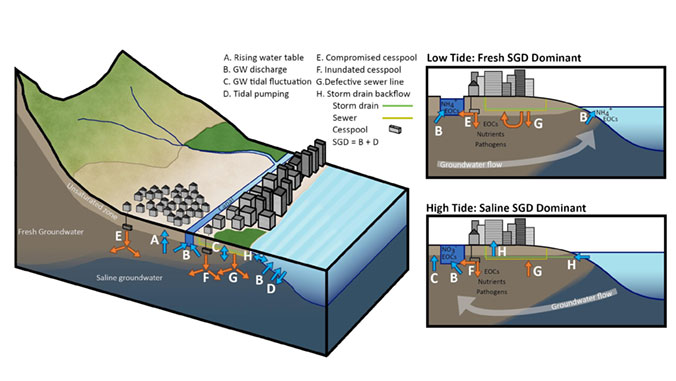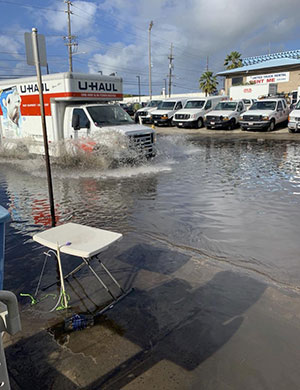
When people think of sea-level rise, they usually think of coastal erosion. However, recent computer modeling studies indicate that coastal wastewater infrastructure, which includes sewer lines and cesspools, is likely to flood with groundwater as sea-level rises.
A new study, published by University of Hawaiʻi at Mānoa Earth scientists, is the first to provide direct evidence that tidally driven groundwater inundation of wastewater infrastructure is occurring today in urban Honolulu. The study shows that higher ocean water levels are leading to wastewater entering storm drains and the coastal ocean—creating negative impacts to coastal water quality and ecological health.

This research is an example of UH Mānoa’s goal of Excellence in Research: Advancing the Research and Creative Work Enterprise (PDF), one of four goals identified in the 2015–25 Strategic Plan (PDF), updated in December 2020.
Chemical tracers detect wastewater
The study was led by postdoctoral researcher Trista McKenzie and co-authored by UH Sea Grant coastal geologist Shellie Habel and Henrietta Dulai, advisor and associate professor in the UH Mānoa School of Ocean and Earth Science and Technology (SOEST). The team assessed coastal ocean water and storm drain water in low-lying areas during spring tides, which serve as an approximation of future sea levels.
To understand the connection between wastewater infrastructure, groundwater and the coastal ocean, the researchers used chemical tracers to detect groundwater discharge and wastewater present at each site. Radon is a naturally occurring gas that reliably indicates the presence of groundwater, while wastewater can be detected by measuring specific organic contaminants from human sources, such as caffeine and certain antibiotics.
“Our results confirm that indeed, both groundwater inundation and wastewater discharge to the coast and storm drains are occurring today and that it is tidally influenced,” said McKenzie. “While the results were predicted, I was surprised how prevalent the evidence for these processes and the scale of it.”
Threat to ecosystem, public health
During high tides, storm drains are becoming channels for untreated wastewater to flood streets and sidewalks.
In low-lying inland areas, storm drains can overflow every spring tide. This study demonstrated that at the same time wastewater from compromised infrastructure also discharges into storm drains. During high tides, storm drains are becoming channels for untreated wastewater to flood streets and sidewalks. In addition to impeding traffic, including access by emergency vehicles, this flooding of contaminated water also poses a risk to human health.
The team also found evidence that many of the human-derived contaminants were in concentrations that pose a high risk to aquatic organisms. This has negative consequences to coastal organisms where the groundwater and storm drains discharge.
Planning for the future
“Many people may think of sea-level rise as a future problem, but in fact, we are already seeing the effects today,” said McKenzie. “Further, these threats to human health, ocean ecosystems and the wastewater infrastructure are expected to occur with even greater frequency and magnitude in the future.”
For more information, see SOEST’s website.
–By Marcie Grabowski
The Link LonkMarch 15, 2021 at 02:01AM
https://ift.tt/3tk6fAG
Sea-level rise drives wastewater leakage to coastal waters in Honolulu | University of Hawaiʻi System News - UH System Current News
https://ift.tt/2CoSmg4
Sea
/cloudfront-us-east-2.images.arcpublishing.com/reuters/CZF6NULMVVMEXHOP7JK5BSPQUM.jpg)
No comments:
Post a Comment